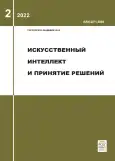Method for DeepFake Detection Using Convolutional Neural Networks
- Authors: Volkova S.S.1
-
Affiliations:
- Vologda State University
- Issue: No 2 (2022)
- Pages: 62-73
- Section: Machine Learning, Neural Networks
- URL: https://journal-vniispk.ru/2071-8594/article/view/270311
- DOI: https://doi.org/10.14357/20718594220206
- ID: 270311
Cite item
Full Text
Abstract
The article proposed the face anti-digital-spoofing countermeasures method for improving the protection of the facial biometric system. The DeepFake detection method is based on the convolutional neural networks, trained on a large dataset that contains different fake types with different qualities. This has resulted in at least 99% of detection quality. The suggested method can be used to increase the protection of facial biometric systems by reducing the risk of unauthorized access.
About the authors
Svetlana S. Volkova
Vologda State University
Author for correspondence.
Email: malysheva.svetlana.s@gmail.com
Candidate of technical sciences. Associate professor, Department of applied mathematics
Russian Federation, VologdaReferences
- The Prosecutor General's Office of the Russian Federation. Department of legal statistics, information technology. 2021. Sostoyanie prestupnosti v Rossii za yanvaroctyabr 2021 [The crime rate in Russia for january-october 2021] // Official portal of legal statistics department URL: http://crimestat.ru/analytics.
- Thies J. et al. Face2face: Real-time face capture and reenactment of rgb videos //Proceedings of the IEEE conference on computer vision and pattern recognition. – 2016.P. 2387-2395.
- Tolosana R. et al. Deepfakes and beyond: A survey of face manipulation and fake detection //Information Fusion. 2020. Т. 64. P. 131-148.
- Korshunova I. et al. Fast face-swap using convolutional neural networks //Proceedings of the IEEE international conference on computer vision. 2017. P. 3677-3685.
- Agarwal A. et al. Swapped! digital face presentation attack detection via weighted local magnitude pattern //2017 IEEE International Joint Conference on Biometrics (IJCB). IEEE/ 2017. P. 659-665.
- Mo H., Chen B., Luo W. Fake faces identification via convolutional neural network //Proceedings of the 6th ACM Workshop on Information Hiding and Multimedia Security. 2018. P. 43-47.
- Agarwal S. et al. Protecting World Leaders Against Deep Fakes //CVPR workshops. – 2019. Т. 1.
- Li X. et al. Fighting against deepfake: Patch&pair convolutional neural networks (PPCNN) //Companion Proceedings of the Web Conference 2020. – 2020. – P. 88-89.
- Li L. et al. Face x-ray for more general face forgery detection //Proceedings of the IEEE/CVF Conference on Computer Vision and Pattern Recognition. 2020. P. 5001-5010.
- Rossler A. et al. Faceforensics++: Learning to detect manipulated facial images //Proceedings of the IEEE/CVF International Conference on Computer Vision. – 2019. P. 1-11.
- Afchar D. et al. Mesonet: a compact facial video forgery detection network //2018 IEEE International Workshop on Information Forensics and Security (WIFS). IEEE. 2018.P. 1-7.
- Ding X. et al. Swapped face detection using deep learning and subjective assessment //EURASIP Journal on Information Security. 2020. Т. 2020. P. 1-12.
- Do N. T., Na I. S., Kim S. H. Forensics face detection from GANs using convolutional neural network //2018 International Symposium on Information Technology Convergence (ISITC 2018). South Korea. 2018.
- Hsu C. C., Zhuang Y. X., Lee C. Y. Deep fake image detection based on pairwise learning //Applied Sciences. 2020. Т. 10. №. 1. P. 370.
- Fernando T. et al. Exploiting human social cognition for the detection of fake and fraudulent faces via memory networks //arXiv preprint arXiv: 1911.07844. 2019.
- Jin X., Ye D., Chen C. Countering Spoof: Towards Detecting Deepfake with Multidimensional Biological Signals //Security and Communication Networks. 2021. Т. 2021.
- Lu Y. et al. Channel-Wise Spatiotemporal Aggregation Technology for Face Video Forensics //Security and Communication Networks. 2021. Т. 2021.
- Wang R. et al. Fakespotter: A simple baseline for spotting ai-synthesized fake faces. arXiv 2019 //arXiv preprint arXiv:1909.06122.
- Fernandes S. et al. Detecting deepfake videos using attribution-based confidence metric //Proceedings of the IEEE/CVF Conference on Computer Vision and Pattern Recognition Workshops. 2020. P. 308-309.
- Khodabakhsh A., Busch C. A Generalizable Deepfake Detector based on Neural Conditional Distribution Modelling//2020 International Conference of the Biometrics Special Interest Group (BIOSIG). IEEE. 2020. P. 1-5.
- Volkova S. S., Bogdanov A. S. A deep learning approach to face swap detection //International Journal of Open Information Technologies. 2021. Т. 9. №. 10. P. 16-20.
- Tarasiou M., Zafeiriou S. Extracting deep local features to detect manipulated images of human faces //2020 IEEE International Conference on Image Processing (ICIP). – IEEE. 2020. P. 1821-1825.
- Tang X. et al. Pyramidbox: A context-assisted single shot face detector //Proceedings of the European conference on computer vision (ECCV). 2018. P. 797-813.
- Xiong X., De la Torre F. Supervised descent method and its applications to face alignment //Proceedings of the IEEE conference on computer vision and pattern recognition. 2013. P. 532-539.
- Sandler M. et al. Mobilenetv2: Inverted residuals and linear bottlenecks //Proceedings of the IEEE conference on computer vision and pattern recognition. 2018. P. 4510-4520.
- Deng J. et al. Imagenet: A large-scale hierarchical image database //2009 IEEE conference on computer vision and pattern recognition. Ieee. 2009. P. 248-255.
- Defazio A., Jelassi S. Adaptivity without compromise: a momentumized, adaptive, dual averaged gradient method for stochastic optimization //arXiv preprint arXiv:2101.11075. 2021.
- Duchi J., Hazan E., Singer Y. Adaptive subgradient methods for online learning and stochastic optimization //Journal of machine learning research. 2011. Т. 12. №. 7.
- Kingma D. P., Ba J. Adam: A method for stochastic optimization //arXiv preprint arXiv:1412.6980. 2014.
- Loshchilov I., Hutter F. SGDR: Stochastic gradient descent with warm restarts //International Conference on Learning Representations. 2017.
- Bayar B., Stamm M. C. A deep learning approach to universal image manipulation detection using a new convolutional layer //Proceedings of the 4th ACM workshop on information hiding and multimedia security. 2016. P. 5-10.
- Khodabakhsh A., Busch C. A Generalizable Deepfake Detector based on Neural Conditional Distribution Modelling //2020 International Conference of the Biometrics Special Interest Group (BIOSIG). IEEE. 2020. P. 1-5.
Supplementary files









